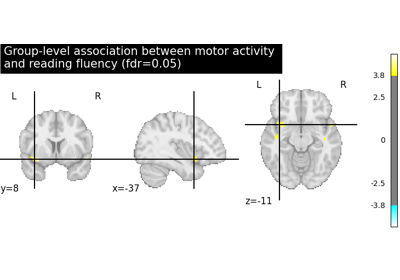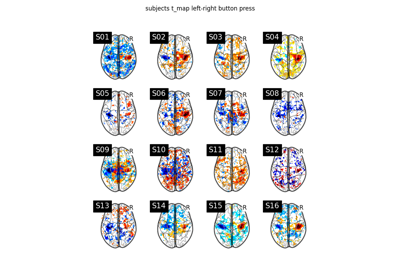Note
This page is a reference documentation. It only explains the function signature, and not how to use it. Please refer to the user guide for the big picture.
nilearn.glm.second_level.non_parametric_inference¶
- nilearn.glm.second_level.non_parametric_inference(second_level_input, confounds=None, design_matrix=None, second_level_contrast=None, first_level_contrast=None, mask=None, smoothing_fwhm=None, model_intercept=True, n_perm=10000, two_sided_test=False, random_state=None, n_jobs=1, verbose=0, threshold=None, tfce=False)[source]¶
Generate p-values corresponding to the contrasts provided based on permutation testing.
This function is a light wrapper around
permuted_ols, with additional steps to ensure compatibility with thesecond_levelmodule.- Parameters:
- second_level_input
listofFirstLevelModelobjects orpandas.DataFrameorlistof 3D Niimg-like objects or 4D Niimg-like objects orlistofSurfaceImageobjects orpandas.Seriesof Niimg-like objects. Giving
FirstLevelModelobjects will allow to easily compute the second level contrast of arbitrary first level contrasts thanks to the first_level_contrast argument ofcompute_contrast. Effect size images will be computed for each model to contrast at the second level.If a
DataFrame, then it has to contain subject_label, map_name and effects_map_path. It can contain multiple maps that would be selected during contrast estimation with the argument first_level_contrast ofcompute_contrast. TheDataFramewill be sorted based on the subject_label column to avoid order inconsistencies when extracting the maps. So the rows of the automatically computed design matrix, if not provided, will correspond to the sorted subject_label column.If a
listof Niimg-like objects orSurfaceImageobjects then this is taken literally as Y for the model fit and design_matrix must be provided.
- confounds
pandas.DataFrameor None, default=None Must contain a
subject_labelcolumn. All other columns are considered as confounds and included in the model. Ifdesign_matrixis provided then this argument is ignored. The resulting second level design matrix uses the same column names as in the givenDataFramefor confounds. At least two columns are expected,subject_labeland at least one confound.- design_matrix
pandas.DataFrame,stror orpathlib.Pathto a CSV or TSV file, or None, default=None Design matrix to fit the GLM. The number of rows in the design matrix must agree with the number of maps derived from
second_level_input. Ensure that the order of maps given by asecond_level_inputlist of Niimgs matches the order of the rows in the design matrix.- second_level_contrast
strornumpy.ndarrayof shape(n_col), optional Where n_col is the number of columns of the design matrix. The string can be a formula compatible with
pandas.DataFrame.eval. Basically one can use the name of the conditions as they appear in the design matrix of the fitted model combined with operators +- and combined with numbers with operators +-*/. The default None is accepted if the design matrix has a single column, in which case the only possible contrast array((1)) is applied; when the design matrix has multiple columns, an error is raised.- first_level_contrast
strornumpy.ndarrayof shape (n_col) with respect toFirstLevelModelor None, default=None When the model is a
SecondLevelModel:in case a
listofFirstLevelModelwas provided assecond_level_input, we have to provide a contrast to apply to the first level models to get the corresponding list of images desired, that would be tested at the second level,in case a
DataFramewas provided assecond_level_inputthis is the map name to extract from theDataFramemap_namecolumn. (it has to be a ‘t’ contrast).
This parameter is ignored for all other cases.
Added in version 0.9.0.
- maskNiimg-like,
NiftiMaskerorMultiNiftiMaskerorSurfaceMaskerobject or None, default=None Mask to be used on data. If an instance of masker is passed, then its mask will be used. If no mask is given, it will be computed automatically by a
NiftiMasker, or aSurfaceMasker(depending on the type passed at fit time) with default parameters. Automatic mask computation assumes first level imgs have already been masked.- smoothing_fwhm
floatorintor None, optional. If smoothing_fwhm is not None, it gives the full-width at half maximum in millimeters of the spatial smoothing to apply to the signal.
Warning
Smoothing is not implemented for surface data.
- model_intercept
bool, default=True If
True, a constant column is added to the confounding variates unless the tested variate is already the intercept.- n_perm
int, default=10000 Number of permutations to perform. Permutations are costly but the more are performed, the more precision one gets in the p-values estimation.
- two_sided_test
bool, default=False - If
True, performs an unsigned t-test. Both positive and negative effects are considered; the null hypothesis is that the effect is zero.
- If
- If
False, only positive effects are considered as relevant. The null hypothesis is that the effect is zero or negative.
- If
- random_state
intor np.random.RandomState, optional Pseudo-random number generator state used for random sampling. Use this parameter to have the same permutations in each computing units.
- n_jobs
int, default=1 The number of CPUs to use to do the computation. -1 means ‘all CPUs’.
- verbose
int, default=0 Verbosity level (0 means no message).
- thresholdNone or
float, default=None Cluster-forming threshold in p-scale. This is only used for cluster-level inference. If None, no cluster-level inference will be performed.
Added in version 0.9.2.
Warning
Performing cluster-level inference will increase the computation time of the permutation procedure.
Warning
Cluster analysis are not implemented for surface data.
- tfce
bool, default=False Whether to calculate TFCE as part of the permutation procedure or not. The TFCE calculation is implemented as described in Smith and Nichols[1].
Note
The number of thresholds used in the TFCE procedure will set between 10 and 1000.
Added in version 0.12.0.
Warning
Performing TFCE-based inference will increase the computation time of the permutation procedure considerably. The permutations may take multiple hours, depending on how many permutations are requested and how many jobs are performed in parallel.
Added in version 0.9.2.
Warning
TFCE analysis are not implemented for surface data.
- second_level_input
- Returns:
- neg_log10_vfwe_pvals_img
Nifti1Image The image which contains negative logarithm of the voxel-level FWER-corrected p-values.
Note
This is returned if
thresholdis None (the default).- outputs
dict Output images, organized in a dictionary. Each image is 3D/4D, with the potential fourth dimension corresponding to the regressors.
Note
This is returned if
tfceis True orthresholdis not None.Added in version 0.9.2.
Here are the keys:
key
description
t
T-statistics associated with the significance test of the n_regressors explanatory variates against the n_descriptors target variates.
logp_max_t
Negative log10 family-wise error rate-corrected p-values corrected based on the distribution of maximum t-statistics from permutations.
size
Cluster size values associated with the significance test of the n_regressors explanatory variates against the n_descriptors target variates.
Returned only if
thresholdis notNone.logp_max_size
Negative log10 family-wise error rate-corrected p-values corrected based on the distribution of maximum cluster sizes from permutations. This map is generated through cluster-level methods, so the values in the map describe the significance of clusters, rather than individual voxels.
Returned only if
thresholdis notNone.mass
Cluster mass values associated with the significance test of the n_regressors explanatory variates against the n_descriptors target variates.
Returned only if
thresholdis notNone.logp_max_mass
Negative log10 family-wise error rate-corrected p-values corrected based on the distribution of maximum cluster masses from permutations. This map is generated through cluster-level methods, so the values in the map describe the significance of clusters, rather than individual voxels.
Returned only if
thresholdis notNone.tfce
TFCE values associated with the significance test of the n_regressors explanatory variates against the n_descriptors target variates.
Returned only if
tfceisTrue.logp_max_tfce
Negative log10 family-wise error rate-corrected p-values corrected based on the distribution of maximum TFCE values from permutations.
Returned only if
tfceisTrue.
- neg_log10_vfwe_pvals_img
See also
permuted_olsFor more information on the permutation procedure.
References

